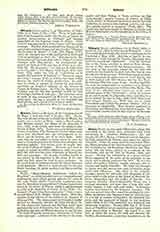

Menas, Saint, martyr under Diocletian, about 295. According to the Greek Acts, published with Latin translation in “Analecta Bollandiana”, III, 258 (Surius, XI, 241), Menas, a Christian, and an Egyptian by birth, served in the Roman army under the tribune Firmilian. When the army came to Cotyaeus in Phrygia, Menas hearing of the impious edicts issued against the Christians by the Emperors, Diocletian and Maximian, left the army, retired to a solitude in the mountains and served God by fasting, vigils, and prayer. During the celebration of a great festival Menas appeared in the midst of the populace in the circus, and fearlessly professed his faith. He was led before the prefect Pyrrhus, cruelly scourged, put to torture, and finally beheaded. His body was brought to Egypt and the martyr was soon invoked in many needs and afflictions. The fame of the miracles wrought, spread far and wide, and thousands of pilgrims came to the grave in the desert of Mareotis between Alexandria and the valley of Natron. For centuries Bumma (Karm-Abum-Abu Mina) was a national sanctuary and grew into a large city with costly temples, a holy well, and baths. A beautiful basilica was erected by the Emperor Arcadius. The cult was spread into other countries, perhaps by travelling merchants who honored him as their patron. As a result of various vicissitudes, the doctrinal disputes and the conquest of Egypt by the Arabians under Omar in 641, the sanctuary was neglected and ultimately forgotten. During 1905 Msgr. C. M. Kaufmann of Frankfort led an expedition into Egypt which made excavations at Bumma. He found in a vast field of ruins, the grave, the well and thermae, the basilica, the monastery, numerous inscriptions on the walls imploring aid through the intercession of the saint, and thousands of little water pitchers and oil lamps. The rich finds are partly in the Museum of Alexandria and Cairo, and partly in Frankfort and Berlin. The monsignor published an official report of his expedition in 1908, “La decouverte des Sanctuaires de Menas dans le desert de Mareotis”. His feast is celebrated on November 11.
Several saints of the name Menas were highly honored in the ancient Church about whose identity or diversity much dispute is raised. Delahaye (Anal. Boll., XXIX, 117) comes to the conclusion that Menas of Mareotis, Menas of Cotyinus, and Menas of Constantinople, surnamed Kallikelados, are one and the same person, that he was an Egyptian and suffered martyrdom in his native place, that a basilica was built over his grave which became one of the great sanctuaries of Christendom, that churches were built in his honor at Cotyicus and Constantinople, and gave rise to local legends.
FRANCIS MERSHMAN

